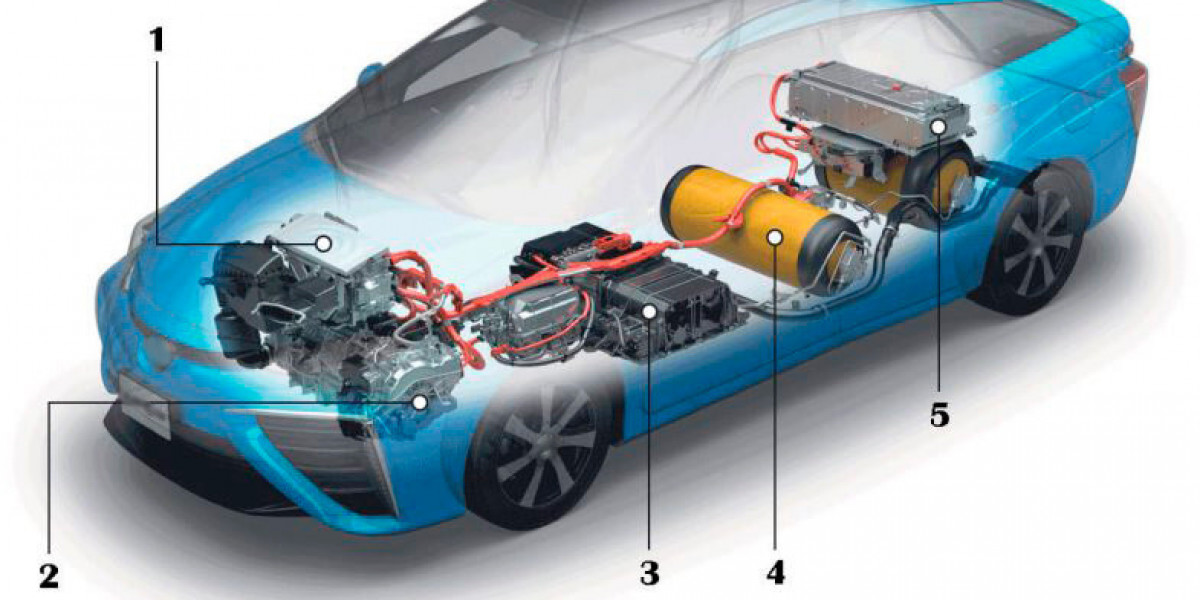How does a Hydrogen Fuel Cell work?
In a hydrogen fuel cell, hydrogen gas enters the anode side of the fuel cell and oxygen gas (usually from ambient air) enters the cathode side. A catalyst causes the hydrogen atoms to split into positive hydrogen ions (protons) and negatively charged electrons. The electrons are routed through an external circuit, generating direct current electricity to power the motor, while the hydrogen ions pass through the electrolyte membrane. At the cathode, the hydrogen ions, electrons and oxygen react to produce water and heat. Unlike batteries, fuel cells can produce electricity as long as a continuous supply of hydrogen and oxygen is maintained. Fuel cells combine hydrogen and oxygen gas at ambient pressure and moderate temperature to generate electricity and heat efficiently.
Advantages of Hydrogen Fuel Cell Vehicles -
One of the major advantages of HFCVs is that they produce zero direct emissions. The only by products are water and heat. This makes them an attractive alternative to conventional gasoline vehicles in regions aiming for lower carbon emissions. HFCVs have a much longer driving range than battery electric vehicles, usually around 300-400 miles on a full tank. While driving range depends on driving conditions and fuel cell efficiency, the refueling time for hydrogen is similar to gasoline vehicles. Hydrogen fueling stations can fully refuel most vehicles in around 5 minutes. HFCVs are also very efficient, with fuel cell stacks achieving over 60% efficiency. Combined with their electric power train, their overall efficiency exceeds most conventional Hydrogen Fuel Cell vehicles. HFCVs are also very quiet in operation compared to gasoline engines since they only have a very small high-speed electric motor and ancillary systems.
Challenges of Hydrogen Fuel Cell Technology -
While HFCVs hold promising advantages, there are still several challenges that need to be addressed for their widespread adoption. One of the major challenges is the lack of available hydrogen refueling infrastructure. Most auto markets do not have enough commercially available hydrogen stations that can provide convenient refueling options for customers. Establishing a widespread network of clean hydrogen production and convenient refueling is critical for customers to feel confident in the technology. Other challenges include the high cost of fuel cells and hydrogen storage tanks. Mass production needs to drive down costs to reach price parity with conventional vehicles. Educating customers about the nascent technology and safety of hydrogen fuel is another hurdle. Other technical challenges involve improving the durability and lifetimes of fuel cell components to meet commercialization targets. Research is ongoing in developing lower-cost, higher-performance materials that can withstand the rigors of automotive operation.
Progress in Hydrogen Fuel Cell Vehicles -
Despite the challenges, considerable progress continues to be made in advancing HFCV technology. Major vehicle manufacturers including Toyota, Hyundai, Honda, BMW and Daimler have developed and deployed HFCV models for lease and demo programs in markets like California, Japan, Germany and South Korea. Strong government investments from Korea, Japan, Germany and California are helping establish the first generation of publicly available hydrogen stations. Scaled manufacturing is driving down costs - some estimates suggest large-scale production could reach cost parity with battery EVs within this decade. Many auto OEMs predict dozens to hundreds of models will be commercially available by 2030 given supportive market conditions and policies. Technologies like proton-exchange membrane (PEM) fuel cells reached higher efficiencies and lifetimes. Advanced composite hydrogen storage tanks now allow ranges exceeding 300 miles while reducing weight and volume. Further innovation in fuel cell materials, power electronics and hydrogen infrastructure deployment will accelerate commercial adoption of HFCVs. Meanwhile, pilot fleet programs are gaining valuable operational experience in buses, trucks and passenger vehicles. Overall, HFCVs continue gaining traction as a potential pathway towards sustainable transportation globally.
Pick the language that you prefer -
Vaagisha brings over three years of expertise as a content editor in the market research domain. Originally a creative writer, she discovered her passion for editing, combining her flair for writing with a meticulous eye for detail. Her ability to craft and refine compelling content makes her an invaluable asset in delivering polished and engaging write-ups.
(LinkedIn: https://www.linkedin.com/in/vaagisha-singh-8080b91)










